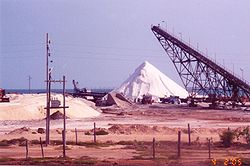
Back Minería en Colombia Spanish Industrie minière en Colombie French Mijnbouw in Colombia Dutch Гірнича промисловість Колумбії Ukrainian


Mineral industry of Colombia refers to the extraction of valuable minerals or other geological materials in Colombia. Colombia is well-endowed with minerals and energy resources. It has the largest coal reserves in Latin America, and is second to Brazil in hydroelectric potential. Estimates of petroleum reserves in 1995 were 3.1 billion barrels (490,000,000 m3). Colombia also possesses significant amounts of nickel and gold. Other important metals included platinum and silver, which were extracted in much smaller quantities. Colombia also produces copper, small amounts of iron ore, and bauxite. Nonmetallic mined minerals include salt, limestone, sulfur, gypsum, dolomite, barite, feldspar, clay, magnetite, mica, talcum, and marble. Colombia also produces most of the world's emeralds. Despite the variety of minerals available for exploitation, Colombia still had to import substances such as iron, copper, and aluminum to meet its industrial needs.
Materials recovered by mining in the country include oil, with proved reserves of 1,506,000,000 bbl (239,400,000 m3) (2006 estimate) and natural gas, with annual production of 6.18 billion m3 (2004 estimate) and reserves of 114.4 billion m3 (1 January 2005 estimate).[1]
Minerals—in particular coal, oil, and natural gas, but also emeralds, gold, and nickel—have played an important role in Colombia's GDP and foreign trade in the last 20 years. Accounting for only 1.4 percent of GDP and 13 percent of total exports between 1980 and 1984, minerals represented about 5 percent of GDP and 42 percent of total exports in 2006. The minerals industry has compensated to a certain extent for the decreasing role of agriculture and has expanded the importance of commodities for the economy as a whole. Colombia is the world's leading source of emeralds, and illegal mining is commonplace. Illegal mining, especially of gold, has grown due to Colombia's aggressive counter narcotics policies, which increase the risks associated with the drug economy.[2] However, production of precious minerals is small scale despite high international prices for minerals such as gold.[3]
- ^ Unidad de Planeación Minero Energética - UPME (2004), Boletín Estadístico de Minas y Energía 1994 - 2004. PDF file in Spanish.
- ^ International Crisis Group. "http://www.crisisgroup.org/~/media/Files/latin-america/colombia/053-the-day-after-tomorrow-colombia-s-farc-and-the-end-of-the-conflict.pdf Archived 2014-12-13 at the Wayback Machine", CrisisGroup.org. 11 December 2014. Retrieved 11 December 2014.
- ^ Roberto Steiner and Hernán Vallejo. "Mining and energy". In Colombia: A Country Study (Rex A. Hudson, ed.). Library of Congress Federal Research Division (2010).
 This article incorporates text from this source, which is in the public domain.
This article incorporates text from this source, which is in the public domain.
© MMXXIII Rich X Search. We shall prevail. All rights reserved. Rich X Search